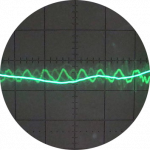This shows difference between the landing radiator (shows a 6) which is performant versus the living 2 small radiator (shows a 3)
Unsure what the central number indicates here, have reached out to Drayton and the numbers on outer ring look to be for balancing TRV side (special key arriving tomorrow from Screw fix so will check what each rad is on)
Rabbit hole over, Drayton responded that number is just a production number. Looking under TRVs I believe the flow rate is indicated by the number facing the inlet to radiator, all are set on 6. Though some appear misaligned but hard to tell without the key (Drayton documentation insists don’t half number this but doubt any are).
That does indicate zero balancing was done plumber side.
I’ll see if adjusting upstairs down somewhat assists downstairs once have the key as the lock shield side offers extremely little range (like the heat geek video talks about). I did seem to get some upping temp downstairs gradually by effectively turning off upstairs rads with lock shield but was difficult to control the room temps and drove other half mad as anything above 19C isn’t comfortable for sleep. Using the TRVs seems to cause more cycling which I’ve had to revert back to in meantime.
Plus also check the heat being drawn is equalised across rads. I believe this should be around 5C for a ASHP flow rate?
Posted by: @crimsonim going to have a look round the house under the TRVs as I’ve noticed and not sure it’s clear in my photo, that the problem room, the worse rad shows a number 3 in the centre of the TRV. Whereas checking in one of our performant bedrooms that shows 4s. I don’t know if that’s just something that changes as water passes through or a preset, finding it hard to see documentation referring to that part.
This could be your smoking gun. Its a preset, lower value restricts flow more. so even with the TRV head set to max (or removed), it'll never let through more flow than what this preset allows.
My octopus signup link https://share.octopus.energy/ebony-deer-230
210m2 house, Samsung 16kw Gen6 ASHP Self installed: Single circulation loop , PWM modulating pump.
My public ASHP stats: https://heatpumpmonitor.org/system/view?id=45
11.9kWp of PV
41kWh of Battery storage (3x Powerwall 2)
2x BEVs
Posted by: @iancalderbankPosted by: @crimsonim going to have a look round the house under the TRVs as I’ve noticed and not sure it’s clear in my photo, that the problem room, the worse rad shows a number 3 in the centre of the TRV. Whereas checking in one of our performant bedrooms that shows 4s. I don’t know if that’s just something that changes as water passes through or a preset, finding it hard to see documentation referring to that part.
This could be your smoking gun. Its a preset, lower value restricts flow more. so even with the TRV head set to max (or removed), it'll never let through more flow than what this preset allows.
Hi Ian, turned out just a production number, got it confirmed with Drayton. Rather confusing thing to have lol. Had hoped it was a eureka moment but alas no.
Tomorrow morning I should have the Drayton balancing key for these valves and then can verify everything is set to 6 properly (fully open) first. Then adjust upstairs down somewhat, which should be easier now the levels will be defined, was murder with the lockshields as the level of movement between on and off was very little (like that YouTube video).
Am trying keeping the TRV heads off downstairs but not seeing much change so hopefully those are factored out as an issue. With a little bit of force can feel the travel on 2 in worse room seems consistent.
Today system seems to have suffered from culling heat out the house yesterday so going to take a while to recover. I’m noticing ASHP not running much and temps side of rads sliding down to 25-23C levels, as cycles are intermittent probably going to take most of the day to come up. And it’s a lot milder today at 12C OAT. Is interesting to note that even the office isn’t 21C yet so perhaps just a lot of heat collected upstairs from when the DH cycle was going up there and levels weren’t as indicative. Will keep my eye on that as that may link back to heat calc issues (delta 20 instead of 16.5 as Derek pointed out).
Apparently plumbers are reworking the calcs so will see if anything comes from that.
Also went round and rebleed rads and found 2 towel rads had a lot of air. With pressure guage back up to 2 bar after.
Today will just be a see how it runs day my end I suspect.
Just wanted to say a thank you to everyone on the thread again.
Funnily enough ahead of the Drayton balancing key arriving tomorrow was watching some videos on balancing and Skill Builders channel had a couple videos about a bad install that the Heat Geek looks at. So much echos this thread on remove bypass, LLH, zone valves etc:
https://youtu.be/1rKNT7-42J0?si=HLnR-UtdOtFbxfoO
Am sending it with the summary notes to the builder and architect to reinforce that all this stuff in the plant room doesn’t help matters, and there’s a great video shot of a load of it on the floor after the rip out.
Hopefully a first round of real balancing tomorrow will help a little with the cycles that are quite brutal again now I’m back on TRVs upstairs. After yesterdays heat crash turning everything off, and doors and windows open. The worse living room is at 19.6C, and that’s with the max LWT up to 41.5C, as I’m slowly hoping to push it up enough with the WC to get the living rooms to 21C as we have family over this weekend. Bedroom above is around 20C so even that hasn’t hit 21C but suspect so much heat loss in the house it’s going to take a while to recovery especially with the cycles.
This has certainly been a learning experience. Hopefully at some point I’ll get there be it with larger rads and further down the line a strip down and simplification
For balancing, finding the order in which between upstairs and downstairs heat up is somewhat difficult to pin down.
So approach I've taken was:
- turn the heating off for an hour
- note down the temps of probes TRV side for most of the radiators (realised missed 3 towel rads)
- turn on the zones
- quickly run round and note the temps
I've then put that in a spreadsheet and mapped degree change and percentage change. Obviously the order in which I run around is going to skew this a little
Is it safest to presume whoever had the bigger percentage change denotes an approx order to work with? Or is it simpler to try and order upstairs, leaving the worser downstairs more open?
Looks something like:
- Ground: Living 2 front rad (larger)
- Ground: Living 1 front rad
- Ground: Living 1 side rad
- Ground: Living 2 side rad (smaller)
- First Floor: Bed 3 side rad
- First Floor: Bed 4 side rad
- First Floor: Bed 3 rear
- First Floor: Bed 4 rear
- Ground: W/C towel
- Ground: Hall tall rad
- First floor: Bed 2 side
- First floor: Bed 2 front
- First floor: Bed 1 front
- First floor: Bed 1 side
- First floor: bathroom tall
- First floor: landing
It is difficult to ascertain, even from the technical data, if the flow through the Eskimo radiators is uni-directional or bi-directional. Are there any markings on the radiators to indicate which pipe connection is the inlet and which is the outlet? The reason I ask is that if the flow is in the reverse direction it may effect the efficiency of operation.
Posted by: @derek-mIt is difficult to ascertain, even from the technical data, is the flow through the Eskimo radiators is uni-directional or bi-directional. Are there any markings on the radiators to indicate which pipe connection is the inlet and which is the outlet? The reason I ask is that if the flow is in the reverse direction it may effect the efficiency of operation.
Unfortunately can't see any indication.
I've for now put Bed 1 on 3/6 using the Drayton tool, Bed 2 on 3/6 also. Bed 4 one is on 4/6 and one on 3/6 as seems to be an imbalance between them. Leaving the office (Bed 3) on 6/6. Will see impacts on room temps and downstairs, before looking at putting probes either side of the rads I guess to ensure take out approx 2-3C, or at least that's even across all rads. I suspect I'll need more probes to make this easier to do, as windows of cycles are small.
One thing I noticed, one rad in Bed 1 can really hear the water flow at 3/6 (whereas others it's only really that audible when down to 1/6). A rad in bed 4 couldn't hear anything when changing this, almost like the lock shield wasn't functioning, or perhaps that just needs to be on 6/6 as potentially at the end of a run.
I'll see if tweaking down all the tall rads helps as well. Then do minor adjustments over time.
It's getting quite mild now, and per architect's warning to the builder it's going to be very hard to determine if any fixes plumbers do have a real impact.
Posted by: @crimsonPosted by: @derek-mIt is difficult to ascertain, even from the technical data, is the flow through the Eskimo radiators is uni-directional or bi-directional. Are there any markings on the radiators to indicate which pipe connection is the inlet and which is the outlet? The reason I ask is that if the flow is in the reverse direction it may effect the efficiency of operation.
Unfortunately can't see any indication.
I've for now put Bed 1 on 3/6 using the Drayton tool, Bed 2 on 3/6 also. Bed 4 one is on 4/6 and one on 3/6 as seems to be an imbalance between them. Leaving the office (Bed 3) on 6/6. Will see impacts on room temps and downstairs, before looking at putting probes either side of the rads I guess to ensure take out approx 2-3C, or at least that's even across all rads. I suspect I'll need more probes to make this easier to do, as windows of cycles are small.
One thing I noticed, one rad in Bed 1 can really hear the water flow at 3/6 (whereas others it's only really that audible when down to 1/6). A rad in bed 4 couldn't hear anything when changing this, almost like the lock shield wasn't functioning, or perhaps that just needs to be on 6/6 as potentially at the end of a run.
I'll see if tweaking down all the tall rads helps as well. Then do minor adjustments over time.
It's getting quite mild now, and per architect's warning to the builder it's going to be very hard to determine if any fixes plumbers do have a real impact.
When you place the temperature sensors on the pipework at the radiators you will be able to observe which pipe heats up first. This will indicate which pipe is the inlet and which pipe is the outlet.
I would expect the position of the inlet pipe and the outlet pipe to be consistent on each radiator, if this is not the case then it may require further investigation.
Thanks Derek, seems consistently the TRV side.
Balancing with the Drayton key seemed to push downstairs up, just dropping living room 2 rads to 5/6 on the larger of the 2 and living 1, 2 of the rads to 5/6. Hit 20C last night, this morning when was a little cooler was around 19.7C after adjusting slightly (putting pine back to 6/6 in living 1) living 2 v 1 as living 1 started to drop a bit in comparison. Both seem balanced now. Upstairs have had no choice but to use TRVs to cap the temperature down as rooms still hit 20.5C even with lockshields TRV side at 2/6. I presume just because of heat rising etc.
Westher suddenly quite mild today and a lot of solar gain so TRVs seem nessecsry in bedrooms at front so I’ve taken all the probes away and having a week off from this other than awaiting what plumbers propose.
It’s been good to ascertain that can’t push downstairs to 21C, so I think it’s clear the rads need an upsize, as with the system cycling so much there’s not enough time for them to draw enough heat.
Next winter I’ll relook at balancing when it’s around -3C which was approx the design flow temp at 40C.
Posted by: @toodles@crimson 😊
thabks toodles for the balancing tip, that’s definately got me further. When it hit 20C last night was a huge joy.
Drayton seem to do themselves a disservice not really advertising the balancing/lockshield element of the TRV4. So easy to adjust and easy to distinguish levels (instead of count quarter turns etc). What I might even do is label the back of the TRVs with the established order of rads so I have that at the rad (will need to do a bit of work on that).
i suspect my endless love for tweaking things in life will have me pull upstairs to 1/6 next week as well.
- 26 Forums
- 2,364 Topics
- 53.6 K Posts
- 194 Online
- 6,029 Members
Join Us!
Worth Watching
Latest Posts
-

How long will your energy contract last?
Some heat pump tariffs don’t run as long as a heat pu...
By Toodles , 10 hours ago
-

@morgan They are unsupervised these days, can’t get the...
By Toodles , 10 hours ago
-
-
RE: Octopus Cosy Heat Pump Owners & Discussion Thread
@kevh it's worth remembering that many lsvs only actual...
By JamesPa , 1 day ago
-

RE: Setback savings - fact or fiction?
Exactly. We only need to compare conditions, to decide ...
By cathodeRay , 2 days ago
-
RE: Balancing financial efficiency and comfort using the Octopus Cosy tariff
I found because I have very low heat loss I can set bac...
By RadWhisperer , 2 days ago
-
RE: Need Help Optimising My Rushed ECO4 Install: 12kW Bosch Heat Pump
Welcome @mickamills We too have an oversized 12kW Sa...
By Old_Scientist , 2 days ago
-
RE: My Powerwall 3 Consumes 3-4 kWh/Day in Self-Consumption: Is This Normal?
@caron I can confirm that the power usage of the PW3 is...
By Old_Scientist , 2 days ago
-
RE: Speedcomfort radiator fans
Thats true, but having tried (and succeeded) in constru...
By JamesPa , 2 days ago
-
RE: Solis S6-EH1P8K-L-PLUS – Why I Chose It and What I’ve Learned So Far
@bash brilliant, thanks for the feedback
By energy9165 , 2 days ago
-

RE: Heat Pump Heats the House… But It’s Not Cosy. Emitter Changes or System Tweak?
@alastair There I was, feeling grumpy, he said “Cheer u...
By Toodles , 2 days ago
-
RE: Grant Aerona: Is there a setting to keep the 2-port valve open during pump blockade
Depends on OAT. Mine cycles at OAT>10 and of course...
By JamesPa , 2 days ago
-
RE: New Fogstar 15.5kWh upright solution
@transparent My conclusion is as you have noted, tha...
By Bash , 2 days ago
-
RE: Mitsubishi Ecodan R290 10kW performance
And to you too. Wishing you a very enjoyable festive s...
By Sheriff Fatman , 2 days ago
-

RE: External pipework insulation
They do? But that isn't apparent from the photos we'r...
By Transparent , 3 days ago
-

RE: Say hello and introduce yourself
@velcro welcome to the forums. Please feel free start a...
By Mars , 3 days ago
-
Daikin EDLA11D3V3 DHW Settings
I have a newly installed EDLA11D3V3 which I'm still get...
By Velcro , 3 days ago
-
RE: Midea ASHP – how to set weather compensation
@curlykatie did you get sorted with this?
By MickaMills , 3 days ago
-
RE: MyVaillant Connect Regular Disconnect
Thanks. Yes, if the time is consistently 11pm every nig...
By buckwem , 4 days ago






